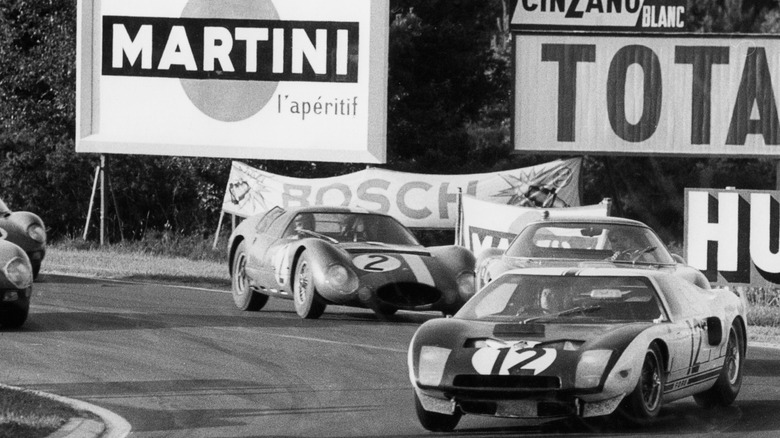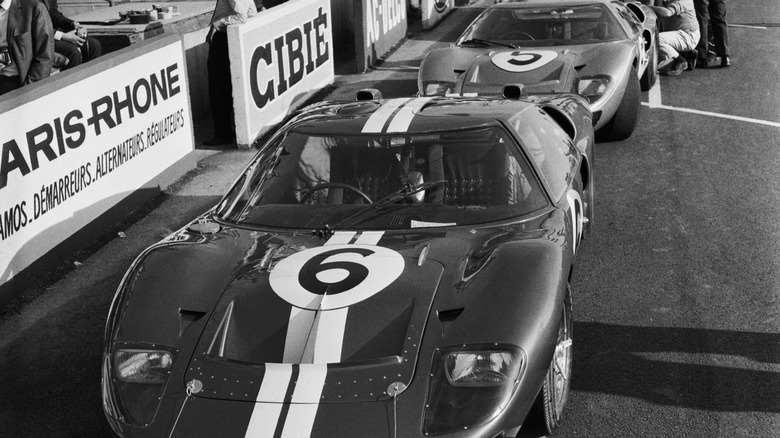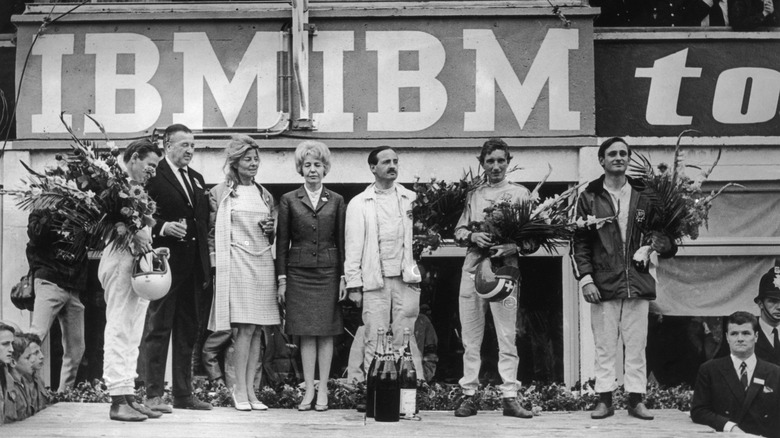A Closer Look At The Ford's 427 V8: The Engine That Made History At Le Mans
Last year marked the 100th anniversary of the 24 Hours of Le Mans, the endurance race run every year since 1923, except when strikes intervened in 1936 and from 1940-1948 during World War II and its aftermath.
The race has been the focus of several movies, including the 1971 Steve McQueen drama "Le Mans" and the 2019 hit "Ford vs. Ferrari." The latter film chronicled the rivalry between the two automakers as the muscle car era dawned in the United States. By the early 1960s, Ferrari had come to dominate Le Mans, and when Ford failed to buy Ferrari, it spared no expense in its effort to beat the Italian automaker on the track. Ford purchased a Lola Mk6 chassis as a base for their endurance racer and hired Lola engineer Eric Broadley and test drivers Bruce McLaren and Phil Hill. The first GT40 models were powered by a 289 cubic inch V8 borrowed from the Fairlane, but all three cars Ford sent to Le Mans in 1964 broke down, and Ferrari took its fourth straight Le Mans win.
Later that year, Ford hired Texas auto industry legend Carroll Shelby to coordinate its Le Mans team, and Ford moved its endurance racing operations to Los Angeles. Shelby's engineers made changes to the GT40's aerodynamics and lightened the body a bit, and those adjustments brought Ford its first endurance race win at Daytona in February of 1965.
The 427 debuted in the Spring of 1965
Bigger changes would soon come under the hood of the GT40, however. While Shelby and his crew worked on the body and chassis in California, engineer Roy Lunn was at Ford's Dearborn, Michigan headquarters trying to figure out how to wedge the automaker's new 427 cubic inch V8 into the GT40's engine bay. After the Spring 1965 time trials at Le Mans, drivers Ken Miles and Phil Remington headed to Michigan to test the new configuration, dubbed the GT40X. According to Ford's website, after driving the GT40X, Miles told Lunn, "That is the car I want to drive at Le Mans this year."
The GT40X's 427 V8 was based on the engine that Ford introduced in 1963 for drag racing Galaxie models and NASCAR racers. Lunn's engineering team designed a new aluminum intake manifold, timing cover, water pump, and cylinder heads to reduce weight. They also replaced the steel oil pan with a cast magnesium version; all together, these updates reduced the weight of the 427 by 130 pounds.
The Le Mans 427 also featured a new oil distribution system that put two pumps in the pan: one to deliver oil at high pressure and one to scavenge oil that settled to the bottom of the engine as it ran. This helped keep the car's center of gravity low and eliminated the need for an external pump.
Ford dominated at Le Mans for four years
Engineers also designed a system of exhaust headers that increased the scavenging of exhaust gases, allowing the engine to run close to its 6,400 RPM redline for long stretches at a time. With these upgrades, the 427 could produce 485 horsepower and 475 lb-ft of torque. But with just a few months to prepare two GT40Xs for the 1965 race at Le Mans, the hastily rebuilt transmissions on both Fords failed, handing Ferrari its sixth straight win and seventh in eight years. The updated GT40Mkii that raced at Le Mans the following year had a new 427 V8 capable of 550 horsepower, but that engine was detuned to 485 so it would last the entire 24 hours.
Fords swept all three podium places in 1966, and Dan Gurney and A.J. Foyt won again in a MkIV GT40 the following year. Ford won again in 1968 and 1969, but those race-winning GT40s were powered by a new, lighter 302 cubic inch V8.
Ford later sold the 427 V8 back to Shelby for use in his legendary Shelby Cobra roadster, which could go from 0 to 60 in under four seconds with the big block option. Ford kept the 427 in its line until 1976, using it in a variety of models from the Thunderbird and Fairlane to the F-100 pickup. Ford also offered a street-legal version of the 1966 Le Mans-winning GT40, but only 20 were sold to customers.


